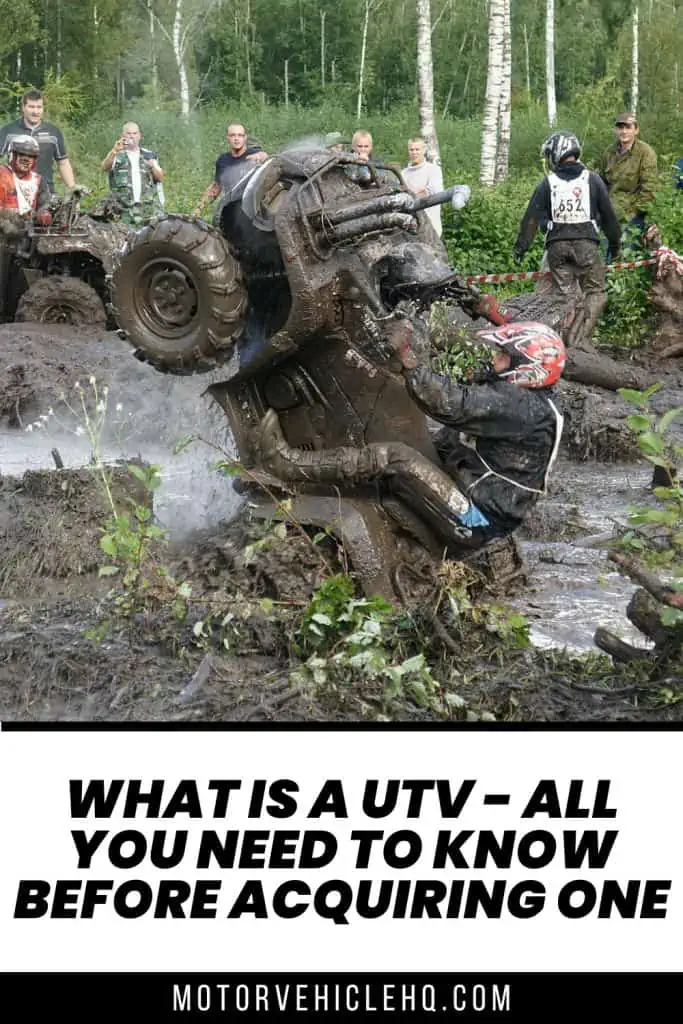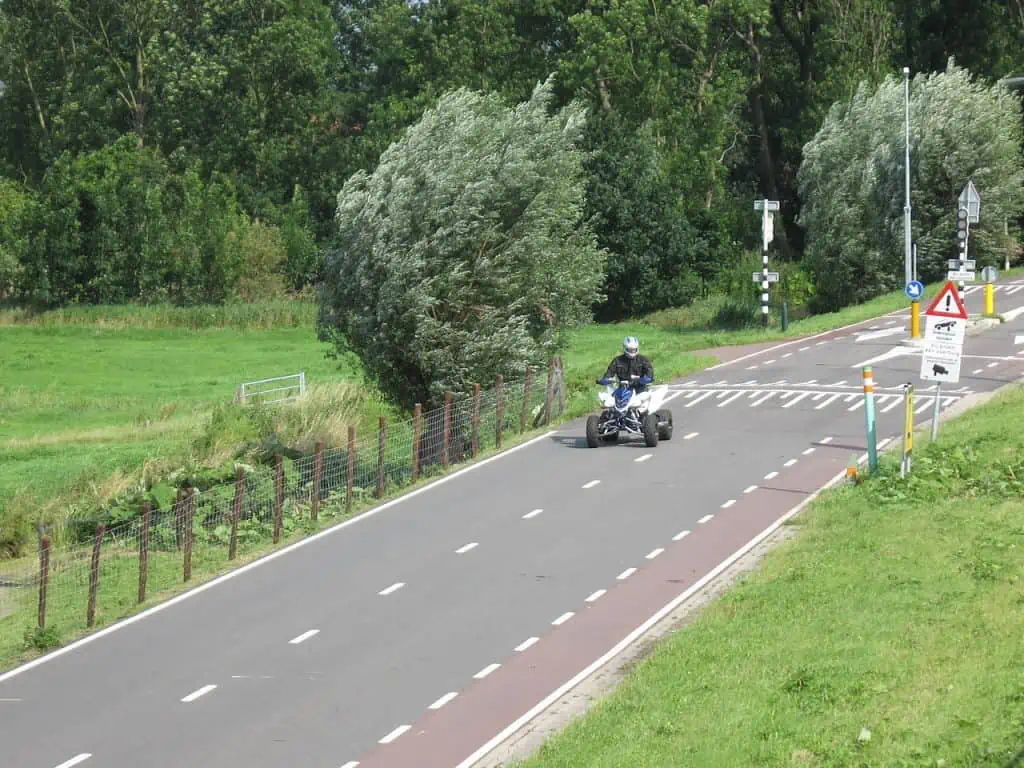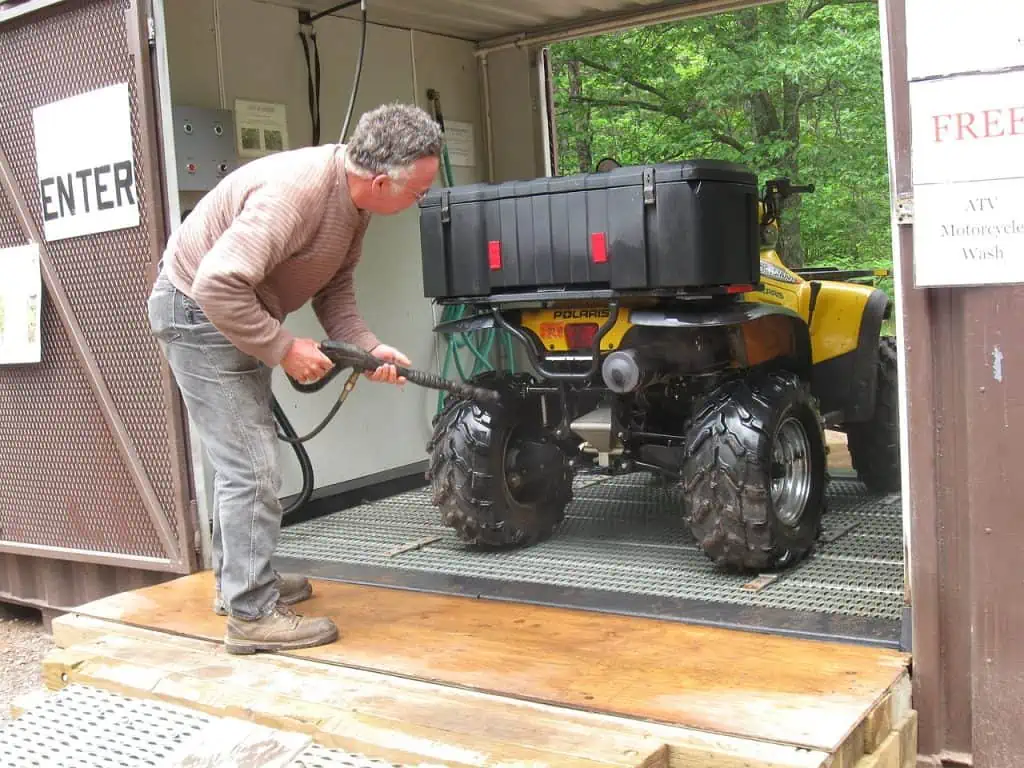Are you considering purchasing an ATV for yourself, but you’re also curious about what a UTV is? If that’s the case, you’ve come to the correct place because we’re going to talk about several things related to these cars and we’ll help you pick one.
It may be challenging for you to comprehend all of these new acronyms and words if you are new to the quad world.
But don’t worry; we’ll go over everything in great depth so that by the time we’re done, you’ll know everything there is to know about these automobiles.
Many have been asking themselves what is a UTV recently as these vehicles have gained a lot of popularity, which is natural.
There are numerous uses for these vehicles. One of them is their fun factor, which makes driving them fairly enjoyable because they are so swift and versatile.
The utilitarian aspect is the other part. These vehicles are designed to traverse terrain that other vehicles cannot and to overcome insurmountable obstacles.
They are the greatest for this use. Nonetheless, there is a lot about these cars that need to be covered.
Due to this, we will first discuss the history of ATVs in this article and learn more about them. What is an ATV? What are its advantages and disadvantages?
Following discussing the ATV aspect, we will talk about what a UTV is and provide the same information. The best UTVs on the market will thereafter be listed by us. So let’s get going.
A UTV: What Is It?
You’ve heard of the phrase UTV if you’re new to power sports and searching for a small recreational vehicle. This stands for “utility terrain vehicle,” and although these leisure vehicles may not initially seem to be different from ATVs, they are (all-terrain vehicles).
If you’re looking for a UTV, you’ve probably seen how similar they appear to ATVs. Both sorts of vehicles are produced by numerous power sports manufacturers, and most shops that sell one will also stock the other.
As implied by their titles, a UTV has superior performance capabilities and is more suited for various types of work than an ATV. UTVs often have stronger engines with better horsepower and torque ratings.
ATVs are popular in Saudi Arabia by Kskhh / CC BY-SA 4.0. The creation of ATVs in the 1960s helped the idea of an off-road leisure vehicle gain mainstream. In the 1980s, components were added to the basic ATV design to produce the first vehicles that could be identified as UTVs.
To maximize the engine’s power for towing and hauling capacity, a UTV may also have performance suspension systems and more durable four-wheel-drive systems installed or available. They include hauling cargo, going hunting, or pulling farm machinery.
Although it is the primary distinction between the two, several other elements can make one of these vehicle types a better option for a specific customer.
UTVs are sometimes referred to as side-by-sides, or SxS because the driver and passenger sit side-by-side in a single row. This differs from an ATV, which can fit a single passenger behind the rider and has a single seat in the middle for the rider.
UTVs may have more than one seat, but they typically keep a side-by-side configuration. UTVs also have a roll-over protection system, which essentially uses the roof’s support bars to provide structural integrity and keep you safe if the vehicle flips.
Depending on your demands, you might also be thinking about the other type of car if you’re considering one of them.
This article will assist you in determining whether a UTV is the best option for you, whether you’ve already decided on one as your next vehicle or are still comparing its advantages against those of other possibilities.
History of UTV
The 1940s Willys Jeeps and the 1960s Meyers Manx dune buggies are considered the forerunners of the contemporary UTV. The development of ATVs in the 1960s contributed to the rise in popularity of the concept of an off-road recreational vehicle.
The first vehicles that were recognizable as UTVs were created in the 1980s by adding elements to the ATV’s basic shape.
However, there were other vehicles from the 1980s that came before them, like the brief-lived 1970 Lockley Wrangler. Due to its side-by-side seating configuration, this amphibious power sports vehicle stood out from ATVs.
Honda marketed the Odyssey, a pioneering single-seat UTV, from 1976 to 1986. Honda then repurposed the name for a minivan that is still available today.
One of the first UTVs created and sold primarily for farm and other commercial purposes was the Kawasaki Mule in 1988. Honda released a second single-seat UTV in 1989 and 1990 under the moniker Pilot, which it would eventually use once more (now a midsize family-friendly crossover SUV).
During this time, UTVs started to gain popularity and were recognized as a different kind of vehicle from ATVs.
The Rhino, a 2004 product from Yamaha famed for its adaptability, was quickly followed by the Polaris RZR. These cars had exceptional work capacity and performance that was suitable for both leisure and utility.
UTVs are so resilient that the market has even seen growth during periods when both motorcycles and ATVs experienced declines in sales as a result of challenging economic conditions.
Today, UTVs play a significant role in the off-roading subculture and are widely used in industrial and agricultural settings.
A Jiger
The “Jiger,” a six-wheeled ATV that made its debut in 1961, was the first common ATV. A Canadian business called Jiger specialized in off-road vehicles.
The Jiger was designed with the army and off-road enthusiasts in mind when the first vehicles rolled off the assembly lines in 1965. It sold well and immediately turned into a hit.
The Jiger had the advantage of being an amphibious vehicle that could go on both land and water. making it extremely adaptable.
A UTV can go through sandy terrain by Peter Ellis / CC BY-SA 3.0. Because of its resiliency, UTV sales have even increased in times when both motorcycle and ATV sales were declining as a result of difficult economic conditions. UTVs are now commonly employed in industrial and agricultural environments, as well as in the off-roading subculture.
Chicken wire and body filler were used to build the initial Jiger’s body. However, because of the additional weight caused by these materials, technical work was required to make the Jiger lightweight and off-road capable.
The entire thing was re-engineered, and the fiberglass body of the new car was used. It was quite portable and lightweight.
The Jiger corporation’s hallmark color, yellow, was used on the initial automobiles. Moreover, they produced a fiberglass roof that was optional and looked great on the Jiger.
The 148cc engine in the Jiger provided good performance both on and off the road.
Both the US Army and the British Army evaluated this vehicle. But no sales were completed. Even NASA sought several of these vehicles in 1967 to achieve its mission to land a man on the moon.
Unfortunately for Jiger, the Moon Rover’s production was contracted out to the Boeing business.
This company failed in 1968 as a result of this bad fate. Yet this didn’t mean the concept was abandoned. We shall discuss the growing popularity of ATVs in the following chapter. The definition of a UTV will next be discussed.
How Did UTVs and ATVs Rise In Popularity?
After the Jiger was discontinued, Honda decided to launch a new model because they recognized the potential in this market. The ATC was there. ATC, which stood for All-Terrain-Cycle, was the initial moniker for an ATV or UTV.
This ATC was a tricycle with extra-thick tires that also appeared in other TV series including the James Bond film Diamonds Are Forever. And it immediately became popular.
The US90, as it was known, cost roughly $595 and had 7 horsepower. This at the time was an enormous sum of money.
And in the 1970s and 1980s, as more and more off-road enthusiasts bought these vehicles, their popularity only increased.
Suzuki produced the first quad that resembled modern quads in 1982. This was the first ATV with four wheels. The QuadRunner 125 is its name.
This quad represented a development in these vehicles’ architecture. It had an odometer, five forward and reverse, and both. After this ATV, other new variants with larger engines and 4-wheel drive followed.
In 1984, Honda alone sold more than 370,000 of these ATVs, demonstrating how well they were received. which was an absurd quantity for a brand-new product.
Then we go on to the present when ATVs are still among the most well-liked off-road vehicles on the market. What, though, is a UTV?
When we discuss the features of ATVs, we will talk more about them. After that, we shall contrast these traits with those of the UTV. and also discover which is which.
What are the Characteristics of Modern ATVs?
ATV configuration is crucial when it comes to its use. An ATV can be either three-wheeled or four-wheeled in design.
Three-wheelers were very common in the past. Nonetheless, four-wheelers have recently gained popularity among purchasers due to their relative safety compared to three-wheeled ATVs.
Driving an ATV on a paved road by JohannesJ / CC BY-SA 3.0. Honda opted to introduce a new model when the Jiger was retired because they saw the market’s potential. There was the ATC. The early name for an ATV or UTV was ATC, which stood for All-Terrain-Cycle.
The steering on an ATV is done using handlebars rather than a wheel like on other four-wheeled vehicles.
The driver is straddled in his or her seat. The majority of ATVs on the market are designed to carry just one person.
Yet, some of them include room for a second passenger in addition to the driver. But what exactly is a UTV? When we’ve covered every aspect of the ATV, we’ll talk more about that.
1. Acceleration and Braking
The driver’s thumb operates the ATV throttle. The ATV accelerates when the driver depresses the throttle button. Twist throttle is also used by some ATVs. Nonetheless, its owners typically adjusted these. As we are all aware, motorbikes frequently use the twist throttle.
ATVs do not ship from the factory with twisted throttles since doing so makes operating an ATV risky. This is the case since ATVs go over bumpy, uneven terrain, which increases the risk of you accidentally twisting the throttle and inflicting harm on yourself.
There is a brake handle or, on certain ATVs, a foot pedal for braking. Depends heavily on the ATV model you are using. What, though, is a UTV? Later, more on that.
2. Safety and Cabin
ATVs hardly have any safety equipment. Even though some ATVs come with roll bars to safeguard the driver.
Given that ATVs rarely have adequate safety equipment. Consider wearing protective gear at all times. A racing suit with padding on the back, in case you fall on your back, is what we mean by protective equipment. Moreover, this substance will aid in preventing scratches.
Yet it’s not flawless; occasionally, you can still break one or more bones. Because of this, operating an ATV safely is essential to avoiding injuries and long-term effects.
Additional safety gear includes particular gloves, boots, and helmets. One of the most important factors in terms of safety is the helmet. Moreover, remember to wear protective eyewear because mud and rocks can also harm your eyes.
It is important to note that ATVs do not have cabins, even the more feature-rich ones. You are depending on good fortune and hoping it doesn’t rain in this situation. You must contend with the weather, whether it be wind or rain.
3. Purpose and Costs of ATV
The ATV is a well-liked mode of transportation for locations far from populated areas. Let’s say on a mountain or in a forest. Few things can perform as well as they do in this regard, making them an invaluable tool.
SUVs are also capable, although they are not equipped to handle extremely narrow paths with little room for passage.
ATVs are frequently utilized for racing as well. In addition to the motorbike category, many rallies, including the Paris to Dakar rally, also have a dedicated category for ATVs. Not to mention other occasions where these ATVs function brilliantly.
The expenses are again another area where the ATV excels. ATVs are significantly less expensive to buy than UTVs and are much more cost-effective.
They cost more than motorcycles do. Nonetheless, the typical individual can still buy them at a reasonable price and with ease. What, though, is a UTV? That is what the following chapter will be about.
ATVs in New Brunswick, Canada. By Myke2020. The ATV throttle is controlled by the driver’s thumb. When the driver presses the throttle button, the ATV speeds up. Several ATVs also employ a twist throttle. Nonetheless, its owners frequently made adjustments to these. Motorbikes regularly use the twist throttle, as we are all aware.
What are the Characteristics of Modern UTVs?
We must first comprehend what UTV stands for before learning about its features. Utility Terrain Vehicle is the name of the vehicle.
This indicates that this vehicle was designed with labor rather than leisure in mind. Even though many UTVs are made with recreational uses in mind.
The benefit of UTVs is that they have plenty of storage capacity and can accommodate a small number of passengers.
You can transport a lot of equipment with a UTV and never be concerned that you won’t have enough room. But if you don’t have enough space, it happens every time.
Things can easily be secured from the sides without any problems. The UTV is therefore the ideal vehicle for practical purposes.
1. Safety and Cabin
Depending on the UTV, it might include a cabin with doors and front glass. Nevertheless, as many of these UTVs are nothing more than a skeleton of pipework, this isn’t always the case.
Next is the crucial factor, which is safety. One of the most crucial factors when it comes to UTVs is safety. In certain cases, these cars even include racing seats with a dash in front of the driver.
Then there are seat belts that encircle the driver and prevent body movement to the left or right as you cross some bumpy terrain. It is therefore ideal for off-roading.
The driver will always be fastened and their safety will not be compromised by not wearing seatbelts properly.
Not to mention, some UTVs come equipped with a roll bar. The driver and passenger are protected from harm in the event of a rollover by this bar that extends above their heads.
While not all UTVs do so, the majority of them do. It is your responsibility to adequately educate yourself about the safety of the model you intend to purchase.
Also, some UTVs have fully constructed exoskeletons with pipes and other nice things. These UTVs can easily survive being turned over and are utilized for intense off-roading.
We now know what a UTV is, so let’s look at its tires and suspension since it is an important considerations.
2. Tire and Suspension
Both the UTV and the ATV have four wheels. However compared to the ATV, these wheels are much heavier. They have more thread and a greater thickness, making them larger. This ensures that the tire will grip the ground and perform effectively.
Not to mention the suspension, which is significantly more complicated than the one on ATVs. Incredibly, some modern UTVs even include coilover shocks, which makes them handle at high speeds with no driver effort. Also, it will keep you safe while driving.
3. The UTV Steering
As opposed to ATVs, which are driven like standard motorcycles. The UTVs are a lot more intricate. They have ordinary wheels. These wheels are smaller than the wheels on a typical car, yet they function similarly.
Rider cleaning an ATV by Dennis Bratland. ATVs and UTVs both have four wheels. These wheels are substantially heavier than the ATV, though. They are bigger because they are thicker and have more thread. This guarantees that the tire will have good traction and function properly.
As a result, they handle considerably better than ATVs. Because they can perform quite a few more movements than a typical car with an ordinary wheel.
4. The Cost of a UTV
A UTV costs significantly more than an ATV. This is a result of how complicated these vehicles are. after totaling everything. The price increases rather quickly.
You will have to pay more than $20,000 for a UTV if you choose the most expensive upgrades, which would increase the standard UTV’s price from $10,000 to over $20,000. Still, you get what you pay for.
What UTVs Have the Highest Market Performance?
We now understand what a UTV is and how it differs from other types of vehicles. The top UTVs on the market that are currently for sale will be covered in the chapters that follow. So let’s start.
1. Ranger Polaris 570
The best farm UTV available is the Polaris Ranger 570. Due to its exceptional performance, this UTV will simplify your life on the farm.
This UTV has a 44 horsepower engine that can easily tow up to 1,500 pounds and manage a lot of weight. Specifically, its rear cargo capacity is 500 pounds. Great for moving necessary items.
Also, it has a decent suspension system that enables smooth riding and enjoyment of the road. Also, it features higher ground clearance, making it ideal for your off-roading excursions. Do not overlook the skid plate, which will make sure that your undercarriage is protected at all costs.
Also, this UTV is rather small and may easily fit in any confined location. Also, the cost is reasonable. Beginning with $10,999. That will be among the best business decisions for your farm.
2. UTV Honda Pioneer 500
This is a Honda UTV that is even more reasonably priced. The Pioneer 500 is here for you. For the price you pay, this UTV offers a lot of value. As we previously stated, it is far more reasonable and among the most competitively priced quality UTVs available.
not comparable to the Ranger we spoke about earlier. Still a great value for your farm, though. This UTV can tow 1000 lbs, and you may switch between 2WD and 4WD whenever you like.
An independent rear suspension is used by the Pioneer to ensure a comfortable ride. Furthermore to climb hills when in 4WD mode. The price of this model is $8,600. Perhaps one of the best offers available.
3. The Yamaha Viking
We clarified what a UTV is, so let’s talk about the Yamaha Viking now. Another UTV that delivers an almost flawless performance is the Yamaha Viking. especially if you enjoy having outdoor excursions. Lovers of fishing or hunting will adore this item.
The Viking comes with a strong 686cc 4-stroke engine that performs admirably both on and off-road. Due to the high compression ratio of 10.0:1, this is the case. It will never let you down because it features computer fuel injection.
ATV racing on a motocross track by User:Royalbroil / CC BY-SA 2.5. Cost-wise, a UTV is far more expensive than an ATV. This is due to the complexity of these vehicles. calculating the total. The cost rises rather quickly. If you choose the most expensive improvements, your UTV will cost you more than $20,000 and go from costing $10,000 to well over $20,000.
You have access to both 2WD and 4WD at all times and in any location. All of this is made possible by the independent front and rear suspension, which performs admirably.
This UTV has a towing capacity of roughly 1,500 pounds and a carrying capacity of 600 pounds. Which, for a vehicle of this size, is extremely admirable. Excellent stuff all around. The Vikings start at $13,899.
4. Maverick X3 Turbo Can-Am
It’s time to review something crazy right now. The Can-Am Maverick X3 Turbo is that vehicle. One of the most popular UTVs available for purchase is this one.
There is a lot of power in this UTV. You have access to 200 horsepower at any time, to be more specific. The Rotax ACE Turbo RR engine is what makes all of this possible.
This particular model employs a twin A-Arm for suspension. Furthermore, the Can-Am X3 uses FOX racing shocks that were created especially for the Maverick.
The Maverick is now able to drive over anything outside. Making it the ideal UTV for individuals seeking outstanding on- and off-road performance.
There are 4 additional seats in the Maverick, so you are not alone. But you and your three pals can take part in these off-road excursions. Racing harnesses are also supplied for your safety and the protection of your passengers. The Maverick has a starting price of $19,999.
Why Is It Necessary to Purchase a UTV?
A UTV is a multipurpose workhorse with a variety of functions, as was previously mentioned. UTVs are available in a wide range of sizes, from two-seaters for little operations to six-seaters for large jobs or enjoyable family vacations into the wilderness.
Yet, a UTV’s ability to navigate any difficult terrain, including mud, grass, sand, gravel, dirt, and large rocks, is its most crucial attribute. Your passenger car or even your 4×4 truck may spin off or become stuck in deep mud, but a UTV’s knobby tires will enable it to easily navigate those muddy areas.
UTVs may fit into confined places or tiny spots on a building site since they are substantially narrower than a regular passenger automobile. In essence, these cars perform best where a passenger car performs worst, which is a big advantage.
You are not restricted to locating campgrounds that your automobile can access while using UTVs for family camping outings. To begin your excursion on your UTV, simply tow it behind your vehicle, and leave it parked where the road ends.
Take enjoy the scenery as you ride on it along a nature walk. Get your kicks by mudding at fast speeds. For a hunting trip, bring your supplies and your friends. The UTV is a fantastic family vehicle for exploring the wilderness and having a great time while doing it.
In addition to having safety features, UTVs have advantages over other power sports vehicles. Wide-set wheels promote stability, which is also aided by the UTV’s considerable ground clearance. Some UTVs also feature seatbelts and windscreens.
You can undoubtedly find a good reason to use a UTV to make whatever outdoor recreation you enjoy safer, easier to reach, and more practical. A UTV has several uses on construction sites and in office settings, in addition to being entertaining.
All-terrain vehicle in mud by Fred Bauder / CC BY-SA 2.0. The first step in choosing the ideal UTV is deciding how you’ll utilize it. Depending on whether you’re looking for a UTV for farm use or off-road racing, your requirements will change dramatically.
How Can You Choose the Correct UTV?
Determining how you’ll use the UTV is the first step in selecting the perfect one. Your requirements will differ significantly depending on whether you’re looking for a UTV for farm use or off-road racing.
Take into account your budget first. You may purchase some very nice UTVs brand-new, knowing that they have been well-maintained and are ready to be driven as soon as you leave the dealership. Popular and wise investments are the Kawasaki Mule, Polaris RZR, and Arctic Cat UTV models.
A secondhand UTV can be a better option if you’re on a tighter budget. Also, if you want to race your car, you may have extra money to spend on upgrades and improvements. Budget for safety equipment as well, which is essential for racing and includes roll bars and protective clothing.
The Conclusion
We talked a lot about UTVs and ATVs in this article. First, we studied the background of these cars and how everything got started.
Afterward, we discussed the ATVs and the UTV’s qualities before contrasting them in terms of cost, utility, comfort, and driving. We concluded that UTVs are essentially like little autos that may be utilized for a variety of tasks.
Last but not least, we discussed four UTVs, some of the most well-liked models available today. And at a reasonable cost. Two UTVs were included for work and two more for off-roading and other activities. In general, a UTV is a wise investment because it provides excellent adaptability.

All-terrain vehicle in mud by Fred Bauder / CC BY-SA 2.0

Jim Wicks is the founder of MotorVehicleHQ. With over two decades of experience in the automotive industry and a degree in Automotive Technology, Jim is a certified car expert who has worked in various roles ranging from a mechanic, car dealership manager, to a racing car driver. He has owned more than 20 cars over the past 15 years. Ask him about any vehicle you see on the road and he can tell you the make, model and year. He loves the aesthetics of all things cars, and keeps his vehicles in pristine condition.
In his free time, Jim enjoys getting his hands dirty under the hood of a classic car or taking long drives along the country roads. His favorite car? A 1967 Shelby GT500, a true classic that, according to Jim, “represents the pure essence of American muscle.”







